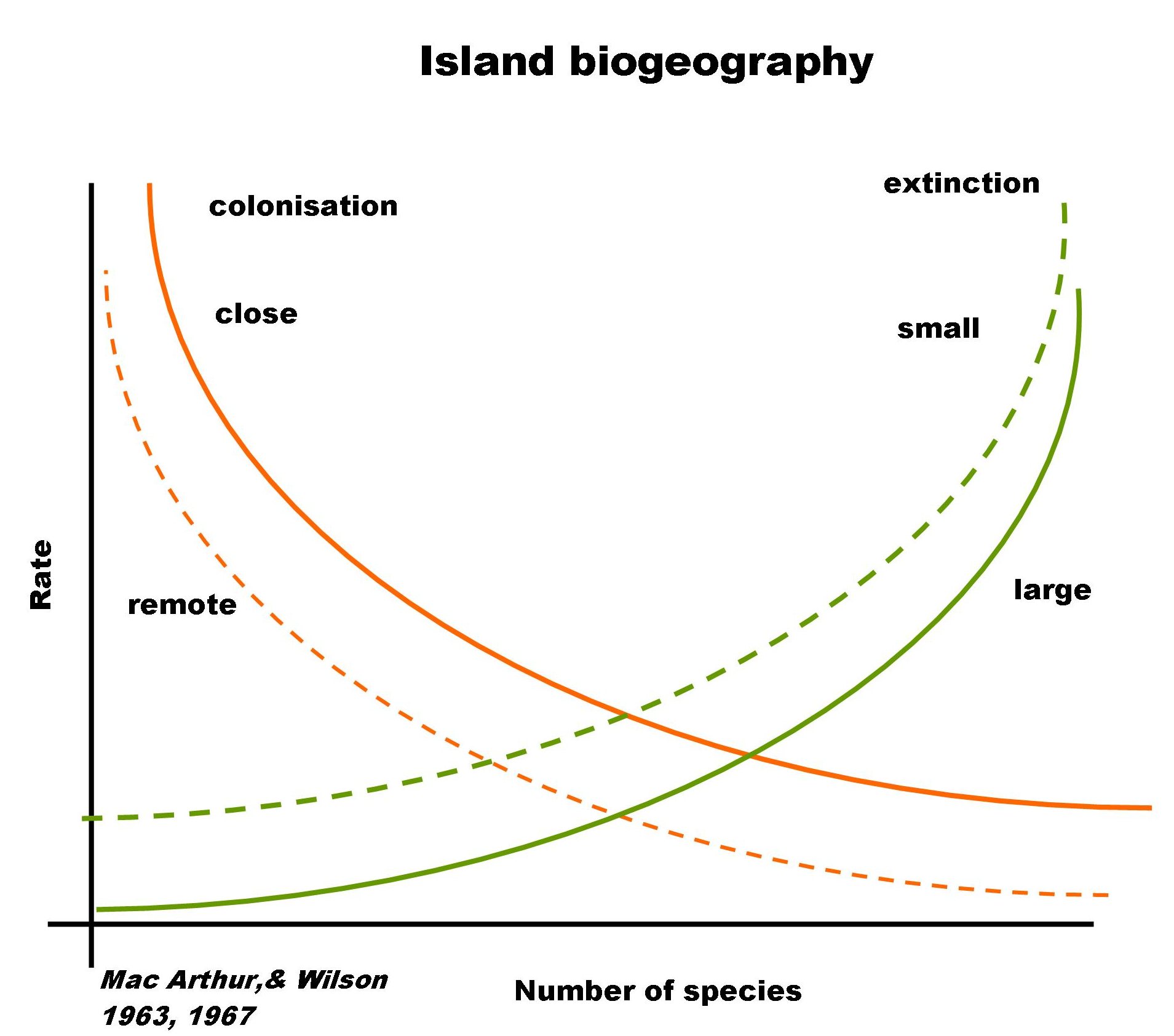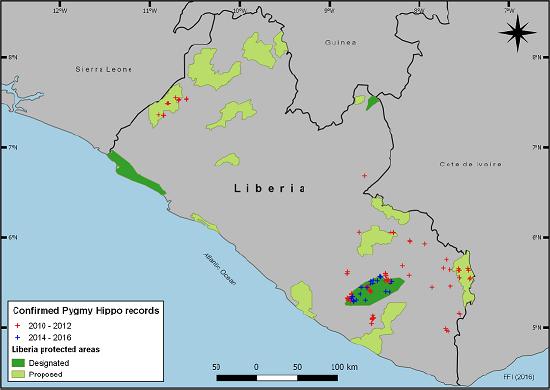9.3: What is Habitat Loss?
- Page ID
- 71467
Habitat loss is defined as the outright destruction of natural ecosystems, an inevitable consequence of expanding human populations and human activities. The theory of island biogeography (MacArthur and Wilson, 1967) offers a good explanation for why habitat loss drives species extinctions. Using oceanic islands as a model system, one of the theory’s main predictions is that large islands have more species than small ones because they can accommodate more individuals, which causes those species to be better buffered against extinctions (Figure 9.3.1). Empirical evidence offers strong support for this observation, also known as the species-area relationship. For example, large African islands generally hold more bird species than small islands (Figure 9.3.2). In addition, 62 of the 79 (63%) Sub-Saharan Africa’s species that went extinct over the past few centuries (IUCN, 2019) have been confined to oceanic islands, rather than the continental mainland which in effect functions like one very big island.


The species-area relationship underpins much of conservation biology today. By applying the relationship’s principles to “islands” of suitable habitat surrounded by a “sea” of damaged or unsuitable habitat (the “matrix”), conservation biologists know that conserving large areas of suitable habitat is much more effective in protecting biodiversity (Box 9.3.1). This is especially true when trying to protect species that have large home ranges, and/or occur in low densities: they can only live in habitat patches that are large enough to maintain viable populations. Observations of extirpations in differently sized habitat patches support this application.
Mary Molokwu-Odozi1 and Kathryn Phillips2
1Fauna & Flora International,
Harmon Compound, Congo Town, Monrovia, Liberia.
2Fauna & Flora International,
Cambridge,> UK.
mary.molokwu@fauna-flora.org, kathryn.phillips@fauna-flora.org
Remaining populations of the pygmy hippopotamus (Choeropsis liberiensis, EN) are found predominately within transboundary West African rainforests spanning Côte d’Ivoire, Guinea, Liberia, and Sierra Leone (Ransom et al., 2015). Liberia contains the largest intact blocks (over 40%) of this Upper Guinean rainforest, a Global 200 ecoregion (Olson et al., 2002). An elusive animal, little is known about the pygmy hippo’s distribution, population status, and ecology. Pygmy hippo numbers are currently estimated at fewer than 2,500 individuals across its range, with the expectation of further decline as a result of agricultural expansion, logging, development, and hunting (Ransom et al., 2015).
Within Liberia, pygmy hippopotamus populations are found in the major forest blocks of the southeast and northwest (Figure 9.3.3), which are separated by an area of degraded land with high human densities (FFI and FDA, 2013). The southeastern forest block is made up of several large chunks of national, communal, and protected forests fragmented by logging routes and concessions. Although populations are well documented within protected areas, recent reports indicate that populations also exist outside formally protected forests (Hillers et al., 2017). The establishment and management of forest corridors linking key habitats is therefore a conservation priority.


It is important to understand that species living in ecosystems that are not conspicuously destroyed may also experience the effects of habitat loss, and hence suffer population declines. This is because habitat loss often manifests itself, at least initially, through less visible but equally threatening habitat degradation. For example, disturbances such as overgrazing do not immediately change the organization of dominant plants and other structural features of an ecological community. First, barely noticeable, a few sensitive habitat specialists disappear, being unable to cope with high levels of grazing. Soon, invasive species that can tolerate trampling start occupying the niches left open by the extirpated sensitive species. Eventually, when livestock eat the last remaining edible morsels of palatable plants not choked out by invasive species, all that is left of the once productive grassland is a field full of dense, unpalatable, invasive shrubbery.
9.3.2 What is habitat fragmentation?
As governments and industries implement measures to accelerate economic growth, ecosystems that formerly covered large, continuous swathes of land are being increasingly subdivided into smaller parcels by roads, farm fields, towns, and other human constructs. This process, known as habitat fragmentation, divides once large and widespread wildlife populations—many already suffering from habitat loss—into several increasingly smaller subpopulations. Habitat fragmentation thereby hastens extinctions, as each of these fragmented subpopulations are more exposed to a range of deleterious genetic effects than the previously large and connected population.
As if they are victims of double jeopardy, habitat fragmentation also impedes these smaller subpopulations’ dispersal and colonization abilities. Most species, especially those that occur in low densities, have large home ranges and/or live in ephemeral habitats, and must be able to move freely across the landscape to find shelter, food, water, and mates. A recent global review found that habitat fragmentation has already reduced the average distance of animal movements by two-thirds—from 22 km to 7 km—over the past few decades (Tucker et al., 2018). If they cannot move freely, these individuals cannot fulfill their needs and are at risk of extinction. Habitat interior specialists are particularly vulnerable to habitat fragmentation, as they are often reluctant to disperse over degraded or cleared areas, even if only a few meters wide (Blake et al., 2008; van der Hoeven et al., 2010).
Physical barriers that impede the ability of wildlife to move freely across the landscape also represent a form of habitat fragmentation. Dispersal impeded by human-constructed barriers, such as railways; dams; water-filled ditches; roads; and fences (Figure 9.3.4), can have disastrous consequences for biodiversity. Consider, for example, Africa’s seasonal drylands. These areas were historically characterized by vast herds of migratory herbivores constantly moving from one area to another after fresh pasture. But as land management systems changed over time, the construction of roads and erection of fences to mark property boundaries impeded the ability of these herds to move freely after the resources they needed to stay alive (Durant et al., 2015; Hopcraft et al., 2015; Stabach et al., 2016). Restricted to only small parts of their range, these once-migratory animals were forced to overgraze the areas they already exploited, leading to extensive population declines.

Habitat loss and habitat fragmentation may even threaten the survival of species that are not as obviously dependent on large-scale movements for survival. As discussed previously, many plants cannot persist without seed dispersal. Unfortunately, many seed dispersers, including forest primates (Estrada et al., 2017) as well as frugivorous birds, such as parrots, orioles, turacos, and hornbills (Lehouck et al., 2009), are sensitive to habitat fragmentation. In one of the few studies looking at this issue in Africa, researchers found that valuable timber trees in Tanzania’s East Usambara Mountains are being extirpated as forest fragments become too small to support viable populations of fruit-eating birds (Cordeiro et al., 2009). The loss of these important seed dispersers will therefore have knock-on effects on the plants that depend on them for survival. Eventually, if enough seed dispersers, or perhaps even a single keystone species, disappear because of habitat fragmentation, entire ecosystems may eventually collapse.
9.3.3 What are edge effects?
Edge effects exacerbate the impact of habitat fragmentation by reducing the functional size of habitat patches.
Edge effects are closely associated with, and exacerbate, the negative effects of habitat loss and fragmentation by altering environmental conditions in the habitat interiors. Dense woodlands, thickets, and forests are especially vulnerable to edge effects. Imagine a tropical forest, especially its large trees forming a continuous leafy canopy. These continuous canopies regulate the microclimate of a forest’s understory by blocking sunlight and wind and maintaining humidity during the day, but also trapping heat rising from the forest floor at night. When the forest’s trees are felled, the continuous canopy is fragmented, which in turn compromises the canopy’s ability to regulate the forest’s microclimate. Cleared areas, as well as forested areas directly adjacent to the cleared areas, will consequently be sunnier, warmer, windier, and dryer during the day, and cooler at night; these climatic changes also disturb nutrient cycles and biomass balances (Haddad et al., 2015). All of these changes further reduce the size of the forest patch to be smaller than the remaining canopy might indicate (Figure 9.3.5) as the new conditions prevent forest specialists such as shade-loving mosses, seedlings of late-successional trees, and humidity-sensitive amphibians from living in forest edges, leaving them with less interior forest habitat for which they must compete. Importantly, these microclimatic changes can penetrate a forest patch over much greater distances than one might expect.

Edge effects also create several additional threats to the forest species already suffering from altered microclimates. Notably, disturbed edge conditions present a favorable environment for colonization by fast growing and fast reproducing invasive species. Those forest species that are not displaced by the altered microclimates and invasive species also face elevated predation risk. That is because trees that have died due to altered edge conditions provide suitable perches with clear views from which predatory birds can hunt (Sedláček et al., 2014). The degraded forest edge, sometimes resembling a savannah structure, also provides opportunities for woodland species such as snakes to enter the forests, pushing the remaining forest species even deeper into the forest (Freedman et al., 2009). For this reason, forest edge communities generally consist of widespread generalist species and invasive species, while specialist species that can hang on are, literally and figuratively, living on the edge.
Edge effects beget further edge effects in a positive feedback loop leading to a rapidly disappearing ecosystem.
The most devastating impact of edge effects is that edge effects beget further edge effects in a positive feedback loop leading to a rapidly disappearing ecosystem. First, expanding invasive (and generalist) species populations at habitat edges can easily overwhelm more sensitive habitat specialists. As habitat specialists are displaced at the contact zones, microclimatic conditions change, which allows for invasions even deeper into the fragmented habitat patch. In this way, invasions systematically penetrate deeper and deeper into the forest as microclimates are disturbed, habitat specialists are displaced, and new contact zones are created. The forest plants that die in the process also increase fuel loads, which, combined with drier and windier edge conditions, create an environment increasingly favorable for fire disturbance. Whether from lightning strikes or human activities, subsequent fires burn hotter and over a larger area (van Wilgen et al., 2007), disturbing and destroying more and more habitat each time. Through these mechanisms, edge effects can degrade entire ecosystems over time, harming both the native species and human livelihoods that depend on those areas.


